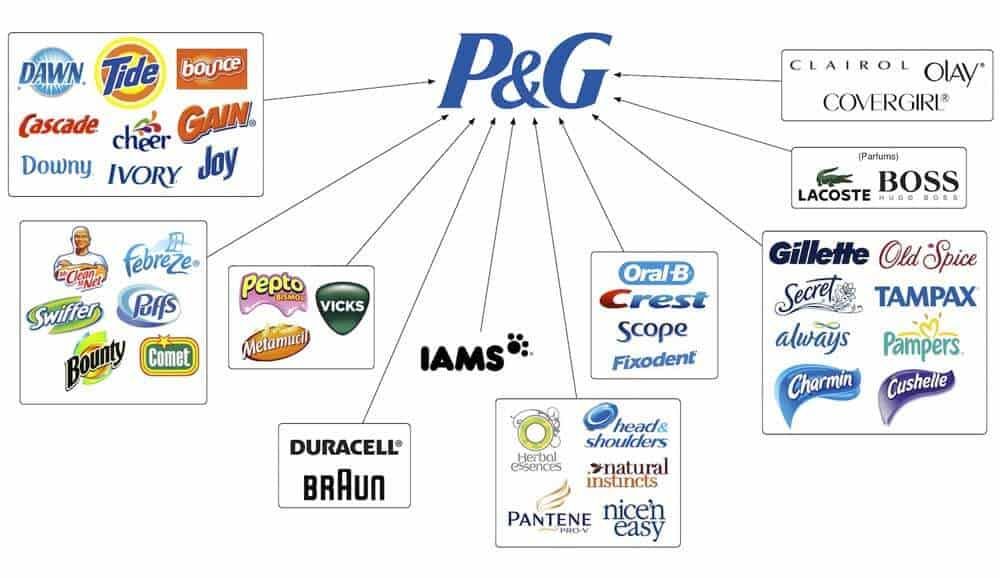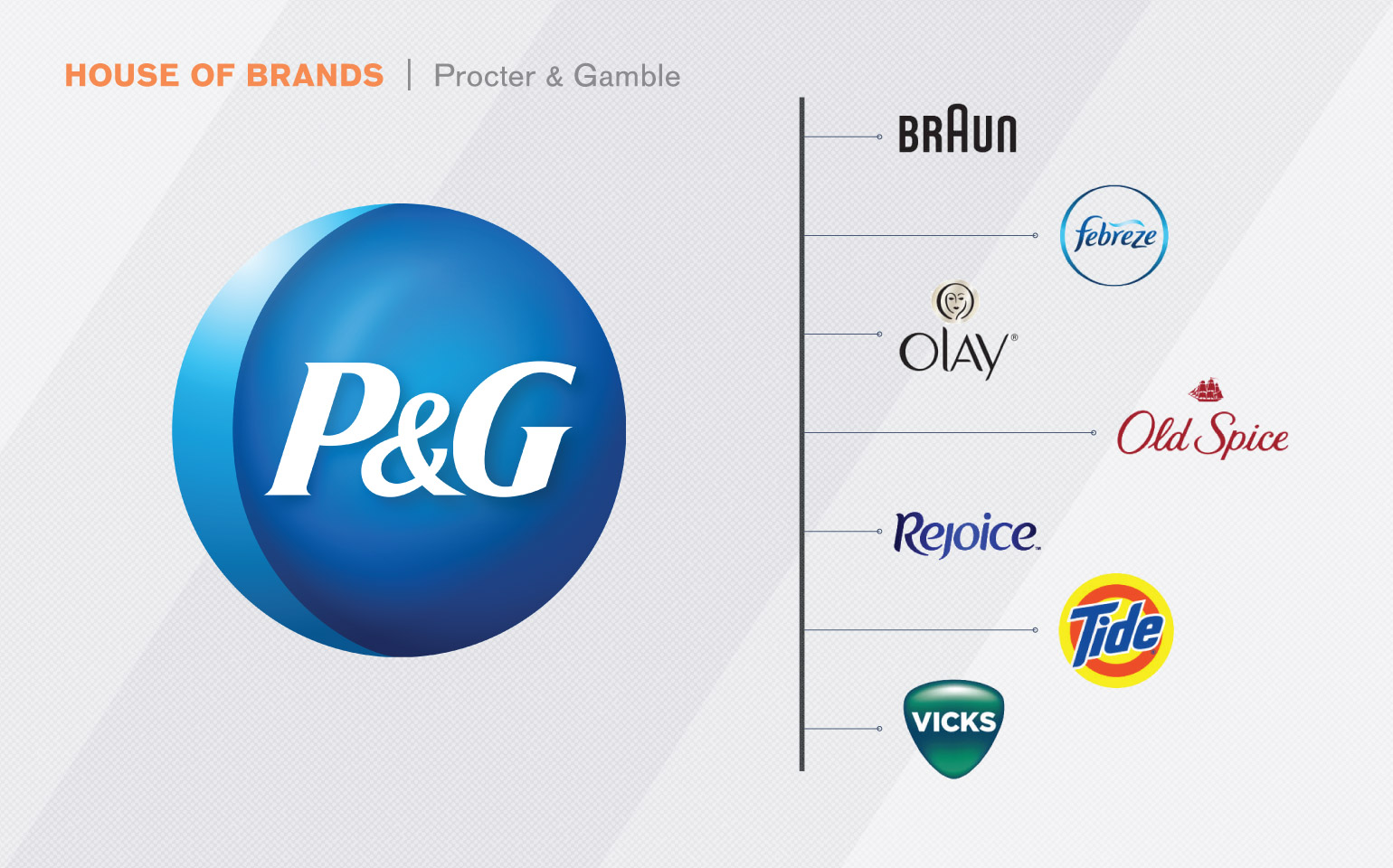Procter & Gamble (P&G) employs “House of Brands” brand architecture strategy that allows for the effective management and positioning of its extensive portfolio of brands.
What is House of Brands strategy?
The “House of Brands” brand architecture strategy refers to a brand management approach where a company maintains multiple distinct and independent brands under its corporate umbrella. Each brand within the portfolio has its own unique brand identity, positioning, and marketing strategies. The individual brands are not explicitly associated with the corporate brand, and the corporate brand may not be prominent in the consumer-facing communication of the individual brands. The focus is on building strong individual brand equities while allowing for brand diversification and targeting various market segments.
Key characteristics and advantages of the House of Brands strategy include:
Brand Differentiation: Each brand within the portfolio has the opportunity to differentiate itself from competitors and establish a unique identity and value proposition. This approach allows for precise targeting of specific consumer segments with tailored branding and marketing strategies.
Brand Autonomy: Each brand operates independently, with its own distinct management and marketing teams. This autonomy fosters a sense of entrepreneurship and accountability, allowing for flexibility and responsiveness to market trends and consumer demands.
Consumer Trust: The individual brands are built on their own merits and reputations, rather than relying on the reputation of the corporate brand. This approach can enhance consumer trust and confidence in the individual brands, as they are perceived as specialized and focused entities.
Market Segmentation: The House of Brands strategy allows for market segmentation, as each brand can target different consumer segments or address specific needs within a broader market. This enables the company to capture a larger share of the market by catering to diverse consumer preferences and creating products that resonate with different target audiences.
M&A Flexibility: The House of Brands strategy provides flexibility in acquiring and integrating new brands into the corporate portfolio. Acquired brands can be retained as standalone entities, maintaining their existing brand equity and consumer loyalty. This approach allows for the preservation of the acquired brand’s identity and market position.
Risk Management: In the House of Brands strategy, risks associated with one brand’s performance do not significantly impact the overall corporate brand. If one brand faces challenges or failures, it does not directly affect the perception and reputation of other brands within the portfolio.
Brand Portfolio Diversity: By having a diverse portfolio of independent brands, the company is less reliant on the success or failure of a single brand. The revenue streams generated by multiple brands provide a level of stability and resilience to the overall business.
Examples of companies that employ the House of Brands strategy include Procter & Gamble (P&G) with its extensive portfolio of distinct brands, such as Tide, Pampers, and Gillette; The Coca-Cola Company with its various beverage brands like Coca-Cola, Sprite, and Fanta; and Unilever with brands like Dove, Axe, and Lipton.
Overall, the House of Brands strategy allows companies to leverage the strengths of individual brands, capture different market segments, and mitigate risks associated with a single brand’s performance. It provides flexibility, market diversification, and the ability to build strong brand equities across various product categories and consumer preferences.
P&G Brand Architecture – Strategy
P&G’s brand architecture is designed to optimize brand recognition, clarity, and consumer trust across its diverse range of products. Here’s a detailed explanation of P&G’s brand architecture:

Corporate Brand
The corporate brand represents the overarching identity of P&G as a company. It encompasses the company’s mission, values, and overall reputation. P&G’s corporate brand serves as the umbrella under which all its products and brands operate. The corporate brand embodies P&G’s commitment to delivering high-quality consumer goods that enhance people’s lives. It reinforces consumer trust and serves as a symbol of reliability and innovation.
Endorsed Brands
P&G employs an endorsed brand strategy, wherein the corporate brand endorses and lends credibility to individual product brands. Endorsed brands have their own distinct brand identities and positioning but benefit from the association with P&G’s corporate reputation. The endorsement enhances consumer trust and confidence in the endorsed brands. Examples of endorsed brands under P&G include:
Gillette: Gillette is a leading brand of men’s grooming products, including razors, shaving creams, and aftershave. As an endorsed brand, it leverages the association with P&G’s corporate brand to reinforce its reputation for high-quality grooming products.
Pantene: Pantene is a popular haircare brand known for its range of shampoos, conditioners, and styling products. The endorsement from P&G’s corporate brand enhances Pantene’s credibility and consumer trust, reinforcing its positioning as a brand that delivers healthy, beautiful hair.
Head & Shoulders: Head & Shoulders is a prominent anti-dandruff haircare brand. The endorsement from P&G’s corporate brand lends credibility to Head & Shoulders’ effectiveness in addressing dandruff concerns and strengthens its position as a trusted solution.
Standalone Brands
P&G also maintains standalone brands that operate independently without explicit endorsement from the corporate brand. These brands often have their own unique brand architectures, target specific markets or consumer segments, and possess separate brand identities. Examples of standalone brands under P&G include:
Tide: Tide is a renowned brand of laundry detergent and fabric care products. It has established its own brand identity and positioning as a trusted and effective solution for laundry needs. Tide’s distinct packaging and marketing campaigns contribute to its recognition as a standalone brand.
Pampers: Pampers is a leading brand of baby diapers and related baby care products. It has built a strong standalone brand identity focused on providing comfort and protection for babies. Pampers’ distinct logo and messaging reinforce its positioning as a reliable choice for parents.
Olay: Olay is a skincare brand offering a wide range of products, including moisturizers, cleansers, and anti-aging solutions. Olay has its own brand architecture, encompassing different product lines targeted at various skincare needs. Its branding emphasizes innovation and effective skincare solutions.
Sub-Brands
P&G’s brand architecture includes sub-brands that exist under individual product brands. Sub-brands are extensions of the core brand, offering variations or specialized products within the same brand family. These sub-brands allow for product differentiation and cater to specific consumer preferences. Examples of sub-brands within P&G’s portfolio include:
Pantene Pro-V: Pantene Pro-V is a sub-brand that focuses on providing advanced haircare solutions, leveraging the power of Pro-Vitamin B5 to strengthen and nourish hair.
Pantene Gold Series: Pantene Gold Series is a sub-brand developed specifically for textured and curly hair, offering specialized products to meet the unique needs of these hair types.
Pantene Expert: Pantene Expert is a sub-brand that provides premium haircare solutions, including intensive treatments and specialized formulations targeting specific hair concerns.
These sub-brands enable P&G to offer a diverse range of products within the Pantene brand, catering to different consumer needs and preferences.
Brand Extensions
P&G utilizes brand extension strategies to introduce new products under established brand names. Brand extensions leverage the equity and familiarity of existing brands to enter new product categories or offer variations within the same category. Examples of brand extensions within P&G’s brand architecture include:
Tide Pods: Tide Pods are a convenient and innovative form of laundry detergent that encapsulates cleaning agents in a dissolvable film. This brand extension provides consumers with a convenient and mess-free way to do their laundry.
Febreze Air Effects: Febreze Air Effects is a brand extension that expands the Febreze line beyond fabric refreshers to include air fresheners, offering consumers a way to eliminate odors and freshen the air in their homes.
Crest Whitestrips: Crest Whitestrips are a brand extension of Crest, offering at-home teeth whitening solutions. This extension leverages Crest’s reputation for dental care and provides consumers with a convenient and effective way to achieve a brighter smile.
Regional and Local Brands
P&G maintains regional and local brands that cater to specific markets and consumer preferences. These brands are often acquired or developed to address regional needs and maintain a local presence. They are designed to meet the unique tastes, preferences, and cultural nuances of specific regions. Examples of regional and local brands within P&G’s brand architecture include:
Ariel: Ariel is a laundry detergent brand widely recognized in Europe. It addresses the specific needs and preferences of European consumers, offering effective solutions for their laundry care.
Safeguard: Safeguard is a popular brand of antibacterial soap and personal care products primarily targeted at Asian markets. It has gained prominence by addressing the importance of hygiene and germ protection in those regions.
Bonux: Bonux is a laundry detergent brand with a strong presence in Latin America. It offers tailored solutions for Latin American consumers, considering factors such as water hardness and garment care practices in the region.
These regional and local brands enable P&G to cater to the diverse needs and preferences of consumers in different markets while maintaining relevance and market share.
P&G’s brand architecture encompasses various brand types, allowing for differentiation, market segmentation, and leveraging the corporate brand’s strength. This strategic approach enables P&G to effectively manage its extensive portfolio of brands, build consumer trust, and cater to a wide range of consumer needs and preferences.
Also Read: Exploring the Brand Architecture of HUL
To read more content like this, subscribe to our newsletter
Go to the full page to view and submit the form.


